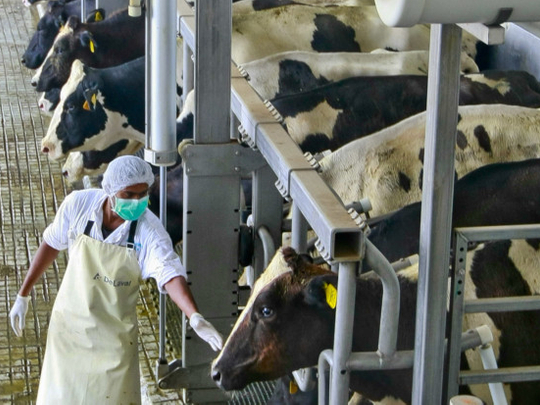
Dubai: Dubai-based Al Rawabi Dairy company has announced plans to expand its reach to the Mena region after penetrating the UAE market for the past 25 years.
The UAE’s largest home-grown dairy company in terms of production capacity and size has plans of further market expansion to Kuwait, Bahrain, and various North African countries, officials said on Sunday as Al Rawabi Dairy marked its 25th founding anniversary.
“We are opening the Kuwait market next May and Bahrain by the end of the year. We now have customers in Sudan, Ethiopia, Tanzania, and we are expanding in northern Africa as well,” Dr Ahmad Eltigani, General Manager of Al Rawabi Dairy Company, told Gulf News.
Starting from just 500 imported cows from Germany in 1989, Al Rawabi Dairy’s herd size has grown to 12,500, some 8,000 of which are milking cows. From just 10,000 litres of milk produced per day then, the company now yields 275,000 litres of fresh milk and 150,000 litres of fresh juice.
“It’s not just the numbers. Al Rawabi Dairy is proud to have contributed to the development of the dairy industry in the UAE,” Abdullah Sultan Al Owais, Chairman of Al Rawabi Dairy Company, said.
“Our growth has been driven by expansions in infrastructure and the introduction of state-of-the-art machinery, animal welfare systems, and methods to reduce our environmental footprint,” he added.
Competition
In 2013, the dairy company expanded its farm costing Dh125 million. It added 3,000 cows to its existing herd, added a new cold store, and enhanced its pasteurisation line at the plant.
Plans are also under way to increase the cold storage area at the farm by 337 per cent from its current size of 858 square metres to 3,750 square metres.
Dr Eltigani said the company has weathered challenges in the market such as stiff competition with dairy companies from other countries that have lower production cost and the high temperature and high humidity of the country.
“These cows from Europe are not acclimatised to high temperature and high humidity. But still we succeeded in producing milk, or even higher than what they’re producing at home by giving what we call ‘cow comfort’, which involves cooling, ventilation,” Dr Eltigani said.
The farm opened its doors to 160,000 visitors during the weekend to allow the public to experience milk production first-hand.
“This is important because nowadays many of the kids here have never seen cows. And when you tell them about milk, they don’t know that milk comes from a cow. They think it’s coming from the manufacturing industry. And if you tell them about a cow, the only image that springs to mind is that of the cartoons,” Dr Eltigani said.







